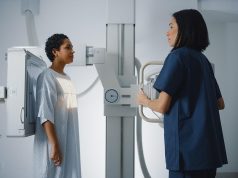Early improvement after adoption of digital breast tomosynthesis seen regardless of DBT volume
THURSDAY, Feb. 28, 2019 (HealthDay News) — Performance improvements after adoption of digital breast tomosynthesis (DBT) relative to digital mammography (DM) performance have been sustained, regardless of DBT volume, according to a study published online Feb. 26 in Radiology.
Diana L. Miglioretti, Ph.D., from the University of California Davis School of Medicine, and colleagues conducted a prospective study involving 106,126 DBT and 221,248 DM examinations in 271,362 women.
The researchers found that the DM recall rate was 10.4 percent and the cancer detection rate was 4.0 per 1,000 cases before DBT adoption. The DBT recall rate was 9.4 percent and the cancer detection rate was 4.6 per 1,000 cases after DBT adoption. For a cumulative DBT volume of fewer than 400 studies, the DBT recall rate decreased relative to DM (odds ratio, 0.83) and remained lower as volume increased (odds ratios, 0.80, 0.81, 0.78, and 0.81 for 400 to 799, 800 to 1,199, 1,200 to 1,599, and 1,600 to 2,000 studies, respectively). For breast imaging subspecialists and readers who were not subspecialists, improvements were sustained. There was a greater decrease in recall rates for women with nondense breasts (odds ratio range, 0.68 to 0.76) compared with those with dense breasts (odds ratio range, 0.86 to 0.90). Cancer detection rates were similar for DM and DBT, regardless of DBT volume.
“Patients with or without dense breasts benefit from lower recall rates with 3D mammography and there is no trade off with cancer detection,” Miglioretti said in a statement.
Several authors disclosed financial ties to the medical device and medical technology industries.
Copyright © 2019 HealthDay. All rights reserved.








